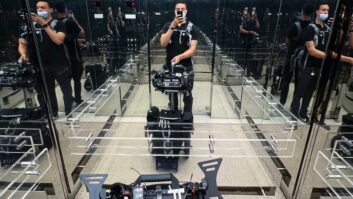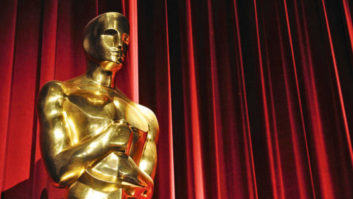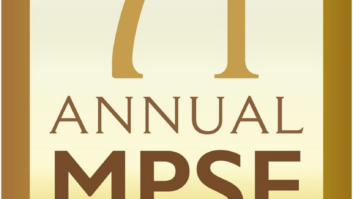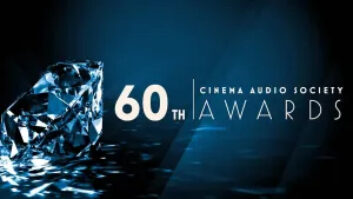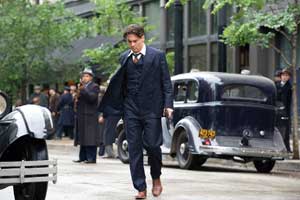
Film still: Peter Mountain/Universal Pictures
Although director/writer/producer Michael Mann is perhaps best known for his gripping and stylish contemporary action films — Heat, Miami Vice and, best of all, Collateral — he also made The Last of the Mohicans; Best Picture and Best Director nominee The Insider; and the underrated biopic, Ali, each brilliant and different as night and day. His latest is the Universal Pictures period crime drama Public Enemies, with Johnny Depp as ’30s bank robber John Dillinger (and Christian Bale as his FBI nemesis), and like all of Mann’s films, it is a carefully drawn character study in an exciting, well-told tale.
Mann is a famously meticulous filmmaker, and his obsessive attention to detail even carries over to sound — he is not one of those directors who lets the sound crew go on its merry way until the final mix and then gives the team a few notes and happily signs off.
“He’s all over this movie because he screens it every day or every other day in his screening room, and he’s got a mixer in front of him and he’ll audition things and try things himself, so you’ll get very specific notes about where he wants to go,” says Jeremy Peirson, co-supervising sound editor (with Laurent Kossayan).
When I spoke to members of the post team in early June, the film was being print mastered, but there was still serious tweaking of both sound and picture going on. “For Michael, it’s all about doing these little moves that in the scene might have a small result, but across the whole have a much bigger impact,” Peirson says. “This is the first time I’ve worked with a director where we’ve really been able to work on a scene as it pertains to the whole movie, not just in the playback of a reel.”
“He gets into changing levels half a dB, a tenth of a dB, and he gets into syllables,” says effects re-recording mixer Beau Borders. “If the line is, ‘Let’s go!’ he might say, ‘Raise the attack of the “g” on “go,” but leave the “o” exactly where it is, and on “Let’s,” I want you to do a rise on the “s.”’ It’s not so much for intelligibility reasons; it’s because Johnny Depp is supposed to be very forceful in the scene so he wants the attack on the ‘g’: ‘Let’s go!’ He alters performances in minute but important ways. If he’s telling you to raise the crickets or lower the air in a scene, it’s not because he wants to hear more crickets and less air; it’s because he has some story-driven intent there.”
“He has an ultra-finely tuned set of ears,” adds dialog and ADR supervisor Hugh Waddell. “He relates everything he does to the drama on the screen. He can be working on dialog in one scene and trying to get one word sounding correct to his ear because it relates to something 20 minutes away in the show. That’s how his process works. It’s a balancing act.”
Mann used as many of the real locations from Dillinger’s saga as he could — from the Little Bohemia Lodge in rural Wisconsin (the setting for a big shootout), to prisons in Statesville and Joliet, Ill., to Chicago’s famous Biograph Theater, where the gangster met his violent end. “One of the very first things Michael said was that he wanted the audience to feel that they were in the period — in 1933 — so that was one of the most important elements we thought of when we did our work,” comments Laurent Kossayan. “That’s also one of the reasons he shot the movie in high definition rather than on film. He made some tests and put what he shot side by side — in film and in HD — and he said that with the HD, he felt it was like it was happening at that moment.”
Production mixer Ed Novick certainly had his work cut out for him working in so many different locations, not to mention the way Mann likes to film a scene, which Waddell says involves “shooting every angle at the same time — close-ups, wide shots…So [Novick] had radio mics on everyone, booms, all kinds of mics where he could, just so he could cover everything.”
Kevin O’Connell, dialog and music re-recording mixer, comments, “Having had the opportunity to personally visit the locations in Chicago, I saw first-hand the challenges that Ed Novick had to deal with, and I’m amazed how well the original production tracks turned out. That was important because this is the first movie I’ve ever mixed without premixing the dialog first. Michael likes to work from the raw dialog tracks and use as little — if any — processing for the mix.”

Some of the Public Enemies sound team (L to R): re-recording mixers Kevin O’Connell and Beau Borders, supervising sound editors Laurent Kossayan and Jeremy Peirson
“Another thing Michael does,” Waddell adds, “is multiple passes on the same take, so they’ll run through the setup and do a couple of passes without stopping. So from my perspective, there’s a sheer mass of material to start with, which is fantastic if you have the time to deal with it, and we did. To be able to go through and find 28 alts for the same word in the same circumstance — same setup, same background noise — that’s priceless gold to us. And the process for Michael is a distillation process as he balances words and sentences against scenes, and then he looks at his film again and again and again so he knows exactly how it’s working and how it’s not working.”
Unlike some directors, who like to use the same sound personnel film after film, Mann has employed mostly different teams through the years, and in this case, the supervisors and re-recording mixers are all people he’d never worked with before. Kossayan, a new member of the Warner Bros. Studios’ stable, has only been living in the U.S. for a year-and-a-half, but previously had done great work in his native France, such as three films by Jean-Pierre Jeunet (including Amelie). This is Peirson’s first gig as a sound supervisor, but he has extensive experience as a sound editor/designer and/or re-recording mixer for film and TV projects, including Watchmen, I Am Legend and animated series King of the Hill. O’Connell has long been one of Hollywood’s top re-recording mixers — his 20 Oscar nominations speak for themselves. And Borders credits O’Connell with getting him into mixing: He learned much as an FX editor on a number of films O’Connell worked on, including Armageddon and Pearl Harbor. After some initial ADR and dialog work at Fox and Todd AO, the main mix was done at Warner Bros.’ Stage 5, with a dozen or so Pro Tools rigs feeding the stage’s Neve DFC.
Tasked with assembling the material that would sell the movie’s 1930s setting sonically, Kossayan and Peirson used new FX recordings and existing library material. “We didn’t have the opportunity to record cars and trains, but we pushed to be able to record the guns,” says Kossayan. “There are several scenes of shootouts, with machine guns and pistols and shotguns, and it was very important for us to record those guns — not only to get the guns themselves, but also to get the spread [ambience]. We went to record near Big Bear [in the mountains east of L.A.] with our recordists J.P. Fasal and Eric Potter, and with Bryan Watkins, who was the editor in charge of all the guns. We went to this orchard there and we recorded these guns, and they had these long tails and then a very, very pure silence. That was good for the Little Bohemia shootout.” For more urban scenes with guns, “We went to the Warner Bros. [N.Y. street] backlot on a Saturday morning, and we put up something like 20 mics — distant mics, closeup mics, overhead mics — and we spent half a day shooting the guns. We wanted to get that city slap and that feeling. We also recorded dirt impacts, wood impacts, things like that.” Recorders for the location FX recording included Sound Devices 702s, 722s and 744s.
How the gunshot recordings were used, however, depended on the scenes in which they appeared. As FX mixer Borders explains, “There’s one scene where Michael is trying to show how the bad guys have the better technology, the faster cars, they’re more organized and they’re much more aggressive than the cops. In this particular scene, we relied on the original recordings that Laurent and Jeremy provided, and that’s where you hear the machine guns being aggressive and scary and startling. They’re in the subwoofers, they’re coming out of the surround speakers. You cut to a cop and he’s got a little .38 gun that sounds like a peashooter compared to these Tommy guns.
“Now, fast-forward to later in the film — there’s a scene where there’s a bank heist that goes wrong. It’s another quick scene, but this time it’s all about disorganization, about the plan falling through — chaos and disorder. And when you hear the sound in this particular scene, you’re not going to hear giant, lush recordings; you’re going to hear an amalgamation of production recordings and sound effects, you’re going to hear things chopping off on cuts, you’re going to hear breathing and the re-loading of a gun louder than a gunshot. You’re going to hear things out of balance from the way you would normally perceive a machine gun battle, and it makes it feel disorganized.”
Peirson notes, “Whatever sells the story is the most important factor; whatever helps you link the pieces together is key to [Michael — things that either put you in that location or help you understand the feeling of anxiety or tension that you’re supposed to get. And it’s never obvious what will do that. For instance, in the gun battle shootout in Little Bohemia, we had recorded all these guns and auditioned spaces for them to be in so we could get how that gun would sound in that place, and in the end our first pass was too much — it was too brutal and assaultive, and very much what you’d expect in an action movie. So we actually unwound it to a certain degree and now we’re using a mixture of the production guns, which really do sound like they’re there, and some of our guns. And there’s a sort of asymmetry to it that’s very effective. The guns aren’t always at the same level — some will pop up and are designed to surprise you.”
When it came to other period touches — cars, planes, trains, phones, flashbulbs, etc. — the team availed themselves of copious amounts of library material, and then customized and sweetened as need be, and the big ’30s cars were pieced together from new and old car sounds. “In 1933, V8 engines were brand new,” Kossayan notes, “and there hasn’t been that much progress with the V8 since. So a 1933 car sounds almost exactly the same as a Suburban now. What you imagine from the cars of that period is the engines going ‘putt-putt-putt-putt’ and it’s absolutely not true. These were powerful V8s.”
Even so, often what Mann was looking for was not the sound of that V8: “There’s a moment where a car pulls in, right up to camera,” Borders recalls. “I love cars — cars are my life — so of course I got the old flathead V8 recording. You hear it rumbling in, it comes to a nice stop. But Michael wasn’t liking that. [Laughs] He wanted to hear the grit of the tires and the creaking of the suspension, because if you put your ear right next to that car, that’s what you’d hear. The sound effects guy in me wants to hear the motor, but the filmmaker in Michael wants you to lean into the screen and be a part of it.”
There were innumerable other details to work out, from the primitive sound of the police’s telephone recordings of the Dillinger gang’s conversations (captured on actual vintage Storno disc machines) to the sounds inside a ’30s prison to the street walla outside the Biograph Theater (assembled in part from actual random street recordings made by Peirson) and so on. The show required both tremendous creativity and an unblinking attention to detail. Add in Elliot Goldenthal’s score — which has elements of ’30s music in places — and original jazz pieces by Bruce Fowler, as well as source material from the era, and you’ve got a recipe for one very complicated mix.
In the end, what the sound team delivered was an often subtle and sophisticated soundtrack, “not what you usually find in the traditional July 4th summer action, popcorn movie,” Borders says. “But everything in there helps tell the story; that’s what Michael is all about.”
O’Connell is equally effusive: “I have never learned more about mixing on a movie than I have on Public Enemies, and that’s because of Michael Mann. I consider him one of the finest filmmakers I have ever worked with.”




